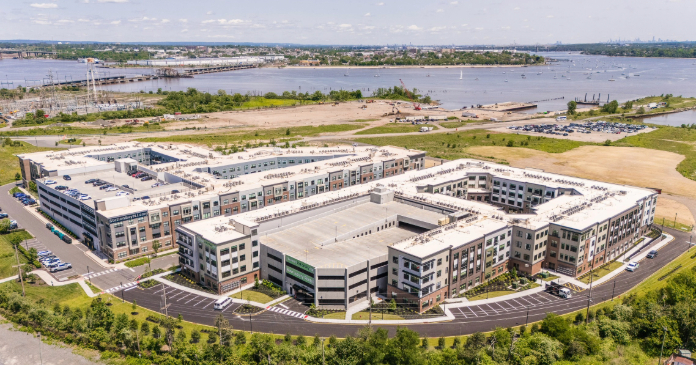The company that owns, manages or is a joint venture partner in 97 apartment communities consisting of a total of 19,805 units located in the Midwest, the Mid-Atlantic and the Southeast, doesn’t quite make the National Multi Housing Council’s top 50 lists, which are based on number of units owned and managed.
But like its larger peers, AEC is enhancing property Websites to drive more traffic via the Internet, moving toward the ability to lease online and updating its model apartments and clubhouses in order to continue pushing rents.
With new marketing initiatives in the works and a migration to higher- growth markets underway, the 43-year-old company is looking forward to a good year of NOI growth in 2008.
AEC’s presentation at last month’s NAREIT conference in Las Vegas focused on the company’s positive third quarter performance. Unlike the majority of apartment REITs, which began the year with high guidance and lowered their earnings expectations as the year progressed, AEC started 2007 with a conservative estimate and gradually raised full-year guidance, based on reports of strong operating results from onsite property operators.
The company reported a 9.6 percent increase in total year-over-year revenue in the third quarter and the REIT’s market-rate portfolio experienced a 3.9 percent increase in same-store revenue during the same period. Total property operating expenses from the same- community portfolio increased 8.1 percent due to higher than anticipated real estate taxes and increases to insurance expense, resulting in a 0.5 percent year-over-year increase in net operating income (NOI).
Midwest grown
From market-rate rental, affordable seniors housing and congregate care to retail and office space, AEC has donned numerous hats since the company was incorporated in 1964 as Associated Estates Group. But it wasn’t until the firm went public in 1993 that the builder, manager and operator of apartment communities in the Cleveland, Ohio, area began expanding into other regions.
President and CEO Jeffrey Friedman took the company public in 1993, engineered the acquisition of an investment and advisory business in
1998 and today is directing a portfolio re-positioning plan intended to reduce the average age of the company’s holdings and its Midwest concentration, and could eventually lead to a presence on both coasts.
Currently, 60 percent of the company’s same-store NOI comes from Midwest states. But, in the REIT’s Q2 conference call, AEC Senior Vice President of Operations John T. Shannon told analysts that by the end of 2008–a year earlier than previously projected–50 percent of the company’s NOI likely will be generated by assets in higher- growth markets. Once exposure to the Midwest is reduced, the REIT will look at limiting concentration in any one sub-market to just 15 percent of its total portfolio.
The focus of AEC’s re-positioning plan is to sell non-core properties like the 14-year-old, 104-unit Fleetwood in Houston and older assets like the 39-year-old, 949-unit North Pointe on the shores of Lake Erie in Euclid, Ohio, using proceeds to either pay down debt or purchase newer assets like the one-year-old, 268-unit Bristol at Ghent in Norfolk that the company purchased from Bristol Development LLC in June for $48.3 million, or $180,224 per unit, marking the REIT’s entry into the Virginia market.
Around the time of the Bristol at Ghent acquisition, AEC also purchased its development partner’s 51 percent interest in the seven- year-old, 843-unit Idlewylde in Duluth, located just one-half mile from I-85 and 30 minutes from Downtown Atlanta. Idlewylde boasts two clubhouses with pools and state-of-the-art fitness centers, an interactive water park and a media room with theater seating.
The REIT is marketing its non-core assets to yield-hungry buyers from coast-to-coast, as well as local players like the Cleveland-based K&D Group, which paid $34.6 million for North Pointe at a 4.5 percent cap rate, based on 12 months trailing NOI, and plans to spend about $3 million on renovations at the property that consists of two 22-story high-rises.
AEC sold 11 such market-rate properties since 2006. Last December, the REIT disposed of three assets in Columbus, Ohio, and exited North Carolina with the sale of the 12-year-old, 276-unit Windsor Falls in Raleigh to New York-based Fairfield Properties for $22.8 million, or $82,609 per unit.
Listed for sale today are four 21-year-old communities totaling 1,060 units in Toledo, Ohio, and a 15-year-old, 164-unit asset in Columbus that Freidman doesn’t expect will close until Q1 2008.
Year to date, AEC has acquired $92 million of real estate. In the second quarter, the company raised acquisition guidance for the year from $50 million to between $90 and $150 million but, like many other apartment REITs, chose instead to repurchase shares of its stock, thus benefiting from the discrepancies between public versus private valuations. With the company’s stock trading at a 50 percent discount to net asset value (NAV), AEC purchased a little more than one million shares at an average price of $13.3. Since 2005, the REIT has repurchased almost 20 percent of outstanding shares at an average price of $10.76 per share and, when AEC’s board meets this month, directors likely will increase the authorized amount for additional buybacks.
Meanwhile, AEC has reduced the average age of its portfolio to around 14 years from 19 at the time of the company’s IPO and continues to aim for a more youthful portfolio by purchasing assets that are less than 10 years old. Certified Financial Analyst Dave Rodgers of RBC Capital Markets believes the re-positioning strategy is a positive step toward upgrading the quality and the perception in the investment community of the REIT’s holdings.
Perhaps the company’s biggest image transformation will result from its exit from the third-party affordable-housing management business and the sale of a dozen company-owned affordable assets with a total of 1,254 units, which the REIT expects to complete over the next 12 to 18 months.
Exiting this segment should allow AEC to shed much of the stigma associated with owning and operating affordable housing, as well as provide a more dynamic portfolio regarding rent and NOI growth, an RBC Capital Markets report predicted in September.
The company’s affordable business dates back to the early 1960s, when the economy and the market for conventional apartments went soft. “People may remember the Rust Belt in certain Midwest markets, and we had a period when industry was exiting, business was slowing and there was a significant out-migration of population. At that time, we weren’t able to build much market-rate housing,” said Friedman.
Instead, AEC took advantage of newly created government-sponsored Section 8 programs, particularly for the elderly, and became one of the largest private developers of senior affordable housing in the country, building everything from independent living units to congregate care and nursing homes.
“As a private company, we developed thousands of aging-in-place units. But, by the early 1980s, most of those government programs had either been modified or discontinued and no longer made sense for a profit-motivated business,” he said.
So AEC segued back into the market-rate rental arena and diversified into the retail and flex space while continuing to own and manage affordable housing.
“When we were unable to build our own assets under a government program, we found the land, made the application for the commitment and subsidy allocations and built affordable housing for many non- profit owners and also managed a number of those properties for the sponsors. We built up this management base for third-party affordable in greater Cleveland and Akron that supplemented our market-rate management and our owned portfolio,” he said.
Friedman and his family owned 33 percent of the company when he took AEC public in 1993. He placed 45 market-rate apartments ranging from newly built single-story brick buildings to luxury town homes, all in greater Cleveland and Akron, and a select number of affordable properties that had unlimited dividend distributions into the REIT entity. The affordable properties with limited dividend distributions were not owned by the public company, but as Friedman sold them, many of the new owners retained AEC to manage their properties. “We kept the business because of the synergies associated with our own affordable business,” said Friedman.
But deteriorating margins in the affordable housing sector made that strategy less and less profitable. After the owner of 23 managed properties chose to self-manage, AEC decided the time was right to exit the affordable housing sector altogether.
“What happened is, our third-party partners said, ‘We’re growing our affordable business, you’re not, so we’ll take back those assets and manage them ourselves,'” said Friedman.
Today, all of AEC’s owned affordable properties are up for sale and the company is helping the non-profit owners transfer management of their assets to other management companies. The REIT expects to eliminate 10 jobs at its headquarters and incur an estimated $200,000 in severance costs by the end of that process.
Portfolio rebalancing
Right after its IPO, AEC grew its market-rate apartment business mostly through acquisitions, reaching down to Columbus, Ohio, and up into Michigan, then over into Indianapolis and Pittsburg on its way to becoming the dominant player in the Midwest. AEC also built new product in some of Cleveland’s high-end suburbs, like Aurora and Avon.
The company gained a foothold outside the Midwest in 1998, with the $306 million acquisition of West Palm Beach-based MIG Realty Advisors, Inc., a multifamily asset manager and pension fund advisor. The transaction included 11 stabilized properties and two under construction that were spread across the U.S. When the deal closed, AEC execs knew which of those markets they wanted to continue to grow and which ones they didn’t. They decided to focus on the Southeast and Mid-Atlantic and sold assets in markets where they had no immediate plans to expand their footprint.
As AEC continues growth through acquisitions, Arizona and California are at the top of Friedman’s new market wish list. But for now he may have to be satisfied with growth in the regions where the REIT already has an established presence.
“At AEC, we believe you make money when you buy, not sell. When we analyze the opportunity to have a significant presence in a new market, we need to have a minimum of 1,000 to 1,500 units. So, in looking at Northern and Southern California, we may be able to go and buy one-off assets at a 4.5 percent cap rate, but if we don’t see on the immediate horizon the opportunity to have economies of scale quickly enough to support the on-the-ground supervision we need, we will invest in markets where we already have a presence,” said Friedman, using as example the recent purchase of Bristol at Ghent, which complements the company’s Mid-Atlantic portfolio.
One of the favored ways to enter new markets is through portfolio buys, but Friedman says that, “in spite of the tightening credit market, for those with access to the capital and debt markets, there’s so much available capital chasing a limited supply of assets that sellers typically are negotiating on a property-by-property basis. This is true in all markets, but especially in California and Arizona.”
AEC plans to test drive a kitchen and bath rehab program in Q1 2008 at the 184-unit Reflections in Columbia, Md., obtained in the MIG acquisition. The REIT is allocating $7,500 per unit for upgrades and expects to see a 10 to 15 percent return on that investment. If the program goes well, Freidman will roll it out on a larger scale, beginning with two other assets AEC owns in the Baltimore/Washington area and then possibly across the Southeast portfolio. Today, the Midwest, where the gap between the cost to own and the cost to rent is small, is not included in those redevelopment plans. “But, as rents continue to increase in our targeted Midwest sub-markets at a five to six percent clip, those upgrades may make sense,” said Friedman, adding that, while development is in the company’s DNA, any future ground-up activity likely will be through partnerships with local construction companies. “Our preference would be to align ourselves with the local developer/contractor and use our balance sheet to take down the land. Then the local partner would obtain entitlements and build the property and we would act as construction manager, partner and property manager,” Friedman said.
The ongoing challenge for the company will be to balance cash flow and operating expense during this growth period. “The good news is, all the planets are lined up in the right place this time around. We have relatively no inflation. First-time home buyers are concerned about the commitment to buy a home and there continues to be high demand for quality rental product from an increasing number of echo boomers, a new renter demographic entering the rent pool. It’s a great time to be in the apartment business,” he said.
















